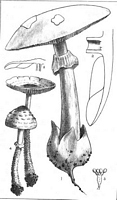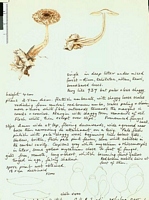|
 Lepiota clypeolaria Lepiota clypeolaria
SynonymsAgaricus clypeolarius
BiostatusPresent in region - Origin uncertain
Images (click to enlarge)
Caption: Fig. 4. Lepiota clypeolaria, Bull. ; natural size. Fig. 5. Section through portion of pileus and
stem of same; natural size. | 
Caption: Watercolour. ID uncertain.
Owner: G.M. Taylor |
Article: Massee, G.E. (1899) [1898]. The fungus flora of New Zealand. Transactions and Proceedings of the New Zealand Institute 31: 282–349 Wellington:.
Description: Pileus at first obtusely cylindrical, even, apex tawny, surface silky and soft but not at all
broken up, then campanulately expanded, umbo tawny, the remainder entirely broken up into
very soft tan-coloured small scales concentric. ally arranged, 4-7 cm. across; flesh thickish,
soft, white; gills free but close to the stem, up to 5 mm. broad, soft, crowded, white or tinged
yellow; spores elliptical, 6 x 4 µ; stem about 8 cm. long, 5-6 mm. thick, soft, fragile, equal or
slightly thickened at the base, at first with spreading scales from the breaking-up of the
yellowish veil, becoming almost naked, pallid, and fibrillose, striate above the ring, stuffed,
then hollow.
Habitat: On the ground, in woods, &c.
Distribution: Northern Island, New Zealand. Europe, United States.
Notes: Characterized by the gills being close to the stem, the concentrically squamulose pileus,
and.scaly stem. Its nearest ally, L. cristata, is not yet recorded for New Zealand. The pileus is
variable in colour, white, pink, rufous, brown, &c.
Article: Horak, E. (1971). A contribution towards the revision of the Agaricales (Fungi) from New Zealand. New Zealand Journal of Botany 9(3): 403-462 (http://www.rsnz.org/publish/abstracts.php).
Notes: Unfortunately, in the absence of any material, it cannot be proved whether the
identification was correct. However, we found on several occasions a species
which showed some similarities to the true L. clypeolaria from Europe, and it
may well be that the New Zealand material represented this species.
|